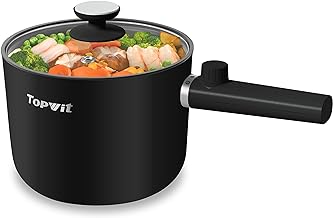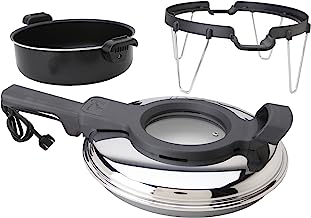Table of Contents
TL;DR:
- building a system around electric heating or cooking is impractical for most people
- but if you have a system that has excess capacity heating and cooking can be an easy way to use up the “extra” power
cooking with excess electrical power
Cooking and heating water with electricity off-grid is usually impractical but there are exceptions. Some setups will have excess capacity that can be put to use. And in some cases even large power loads can be used without affecting house battery1) state of charge:
- if a generator is being run to charge batteries cooking loads can be added
- with lead-chemistry batteries, later in the day excess solar power is available. The actual amount of excess power will depend on what your panels+controller can put out
- with lithium batteries, power can be consumed at any time since Li doesn't need to reach full charge.
Note there is a difference in how much power (W) a cooking appliance consumes and how much energy (Wh) it will consume over a cooking session. This will have real effects on system design, or how you can cook with an existing system.
gear
In general DC power3) is used for warming or very slow cooking. Part of this is due to the limits of cigarette lighter outputs, typically 120w (10A x 12v). The “catch-22” is that most people don't drive their vehicle sufficient hours to do real cooking off DC.
Higher power is common with AC devices but one must have the power to run it, and to recharge the battery bank afterwards.
DC
These devices run off your vehicle's power system, typically 12dc.
- immersion (loop) heaters for DC are typically 150w. Example: RoadPro beverage heater (138w). Caveats:
- heat only water with them; anything else baked on is extremely difficult to clean off the coils
- carry extra fuses in case you blow the ciggy port fuse. Know where the fuses go.
- babysit the heater while in use - if the container falls over or the heater otherwise slips out it can cause a fire.
- unplug before removal from water to avoid overheating the element
- have a safe place planned to set them down before heating; they will be very hot and can melt/burn surfaces after removal from the water
- heated lunchboxes/warmers are large enough to hold hot lunches. They are typically better suited to warming precooked meals rather than cooking from scratch. They come in “lunchbox” and “suitcase” styles.
- lunchbox - hard exterior, typically better insulated tops and higher power.
- RoadPro RPSC-197 (12v/120w) - the most popular model
- Travelisimo 1.5L warmer (12v/40w)
- suitcase - soft exterior, often lightly-insulated tops and lower heating power.
- Hot Logic Mini - a popular model. (12v/45w)
- Sabotheat (12v/90w). Note: has heat levels and timer.
- crockpot/slow cooker typically require many hours of cooking.
- RoadPro 1wt slow cooker (96w), which has a lid retainer for mobile use. Specs say it heats from 140F - 170F.
- 12v rice cookers consume about 100w. Example: Onezili recommended by Americano-with-cream
- heated mugs can be used to keep beverages hot, or heat small amounts of water for tea, coffee. Warm canned soup, etc. Example: Wagan heated mug (12v/24w).
- mini rice cookers. Example: mini rice cooker (12v/100w). Recommended by dannydevitosmgnmdong. See also /r/urbancarlivingcooking.
Also see the 12-Volt Ovens: RoadPro vs HotLogic article on CRLV.
AC (inverter)
Analog cooking appliances (knobs, not electronics) run fine off inexpensive MSW inverters. Some with electronics will require PSW inverters.
- crock pots typically take 125w-200w on HI and half that value on LO.
- the Topwit hotpot (seen at right) used by subbieDev has both 250w and 600w settings. Mug and crockpot style versions are available.
- Instant Pots run 700w to 1200w, depending on size
- mini rice cookers. Normal rice cookers run ~300w but some of the smaller travel ones use less. Example: Dash 200w 1L travel rice cooker (200w).
- immersion (loop) heaters for AC are typically 300w although NOS4) versions can be found for 200w. Example: Norpro 559 immersion heater. (300w)
- this two-burner hotplate has a 600w coil on one side that may be usable in a van.
- small 120vac lunchboxes, as for bento. Example: FIKNEE lunchbox heater, rated 200w and used by Psyckosama.
crockpot vs instant pot
There are some major ways the two differ:
- cost - used crockpots are cheap in thrift stores
- current - crockpots demand much less current, which may also increase the cost of wiring, batteries, and inverter, but…
- energy use - instant pots will generally use far fewer watt-hours to took the same meal5)
also see this post
electric ovens
- Czech cookers (remoska) are pans that have a heating element built into the lid so that it behaves somewhat like an oven or broiler. They typically have a glass viewport and may have one power level (~400w) or a selectable heat setting. Example.
- Dash makes a mini toaster oven (550w)
breaking the 10A barrier
see this article
reducing AC power consumption to run on smaller setups
techniques
Power/time saving
- Preheating water on the dash or elsewhere
- heating only the required amount of water
- reducing power level after reaching a boils (ie, reduce power to simmer)
- covering pots while heating
- pre-soaking beans (overnight) rice (up to an hour), etc
Cleaning
- use parchment paper, foil to line crocks
- lightly oil crocks before cooking to reduce sticking
- immersion heaters might best be used for heating plain water, as the loops can be difficult to clean
resources
- water heating power calculator
- Counter Cooking YT channel


